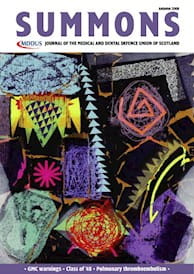IN 1949 HM King George VI suffered a serious flare up of thromboangiitis obliterans – a condition that threatened the viability of his leg. A specialist was called for and due to his reputation as a skilled surgeon in the field of peripheral vascular disease the job fell to James Learmonth. On 12th March, Learmonth carried out, in Buckingham Place and supported by his own anaesthetist and theatre staff, a lumbar sympathectomy which halted the progress of the ischaemia in the King’s leg and produced symptomatic relief. In the immediate post-operative period, the royal patient conferred upon his surgeon, at the bedside, the Royal Victorian Order (KCVO).
This was but one of many honours conferred to this giant of Scottish medical history.
James Rognvald Learmonth entered the Medical Faculty of Glasgow University in 1913 but his studies were interrupted by the First World War in which he served as an officer in the King’s Own Scottish Borderers. He survived some of the bloodiest battles on the Western Front but, in later life, seldom spoke of his war experiences. He was, however, always angered by ill-informed denigration of the British Army’s WWI commanders and was vehement in defence of the military reputation of Field Marshal Haig.
When the war ended, he returned to Glasgow University and, in 1921, graduated MBChB with Honours and the Brunton Memorial Prize. After a number of junior posts, including that of assistant to the Regius Professor of Surgery, in 1924 with a Rockefeller Fellowship, he spent a year at the Mayo Clinic. Back in Glasgow, he obtained his Masters Degree (ChM) and the Fellowship of the Royal College of Surgeons of Edinburgh. At the invitation of Dr W J Mayo, he then returned to the Mayo Clinic as a member of its neurological division and over the next four years conducted research on the innervation of the bladder and on the physiology of micturition, for which he received international acclaim and a reputation as a top clinical scientist.
In 1932, he was appointed Regius Professor of Surgery in the University of Aberdeen. Seven years later, he was appointed to succeed Sir David Wilkie as Professor of Systematic Surgery in Edinburgh. The outbreak of WWII in 1939 meant that the plans for development of his new department had to be postponed but he did manage to establish a special unit for the treatment of peripheral nerve and vascular injuries at Gogarburn Hospital which became an important research centre. The activity of this Unit together with his teaching commitments and the clinical demands of his Royal Infirmary wards, constituted a heavy work load made more arduous by the absence on military service of several members of his departmental staff. In spite of many difficulties, he maintained an impressive research output which was recognised in 1945 when he was made a Commander of the Order of the British Empire (CBE).
In 1946, he was invited by Edinburgh University to fill the Regius Chair of Clinical Surgery in succession to Sir John Fraser and, as the then concurrent holder of two chairs, his academic, clinical and administrative responsibilities were vastly increased.
In 1948, he introduced the famous Saturday morning meetings for the discussion and evaluation of current surgical practices and the review of operative mortality. Soon all the surgical units in Edinburgh were participating in these meetings which were probably the earliest examples in the British Isles of systematic surgical audit. James Learmonth’s early retirement in 1956 surprised his friends and colleagues, most of whom did not appreciate that the strain of his heavy work load had affected his health. He set and maintained the highest standards in everything he did and, if he was a hard taskmaster, there was no-one whom he drove harder than himself. To most of his students and junior staff, he seemed a formidably stern authoritarian figure but, behind this severe façade, lay a deeply emotional, warm personality which was never more apparent than when he was dealing with patients. Even the author of this piece, when a hospital patient for six months, was regularly visited by his ‘Chief’.
Sir James was a rapid dextrous operator and impressive diagnostician who never failed to inspire his patients with total confidence. He was an excellent clinical teacher and his formal lectures, which were models of clarity, always illuminated their subject matter for his audiences at all academic and professional levels. His writing had the same quality and all papers written by members of his University Department had to meet his exacting standards.
He was a great academic surgeon who inspired loyalty, affection and respect in all who worked with or for him. His concurrent tenure of two historic chairs of Surgery in Edinburgh University was a unique achievement which earned him an honoured place in Scottish medical history of which he was, in every way, most worthy.
Iain F MacLaren FRCS
This page was correct at the time of publication. Any guidance is intended as general guidance for members only. If you are a member and need specific advice relating to your own circumstances, please contact one of our advisers.
Read more from this issue of Insight

Save this article
Save this article to a list of favourite articles which members can access in their account.
Save to library